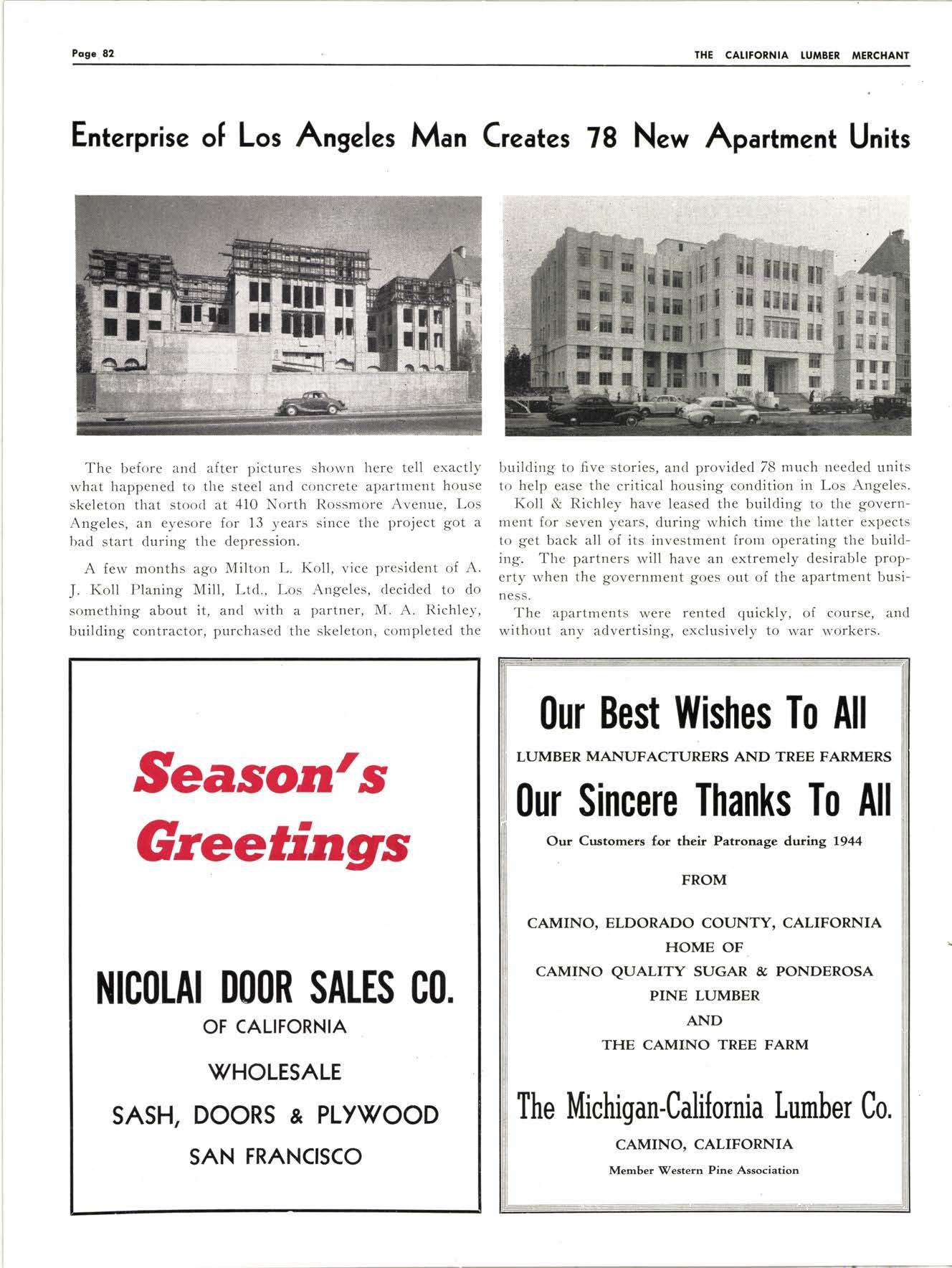
3 minute read
Tnls HlxDBooK-YouRs FOR THE ASKING- TEttS WHERE ADDITIONAT P TYWOOD YOLUME CAN BE FOUNDI
I-HERE'S a day coming when you'll again I I be offering plywood for civilian sale and use! This Handbook is meant to help you make the most of that day.
Here, in compact, readable, interesting form, is a complete survey of plywood-a complete guide to this profitable item. lt tells what plywood items offer sales possibilities to retailers--where and how these items can be sold-where and how additional volume can be developed.
Check this index of subjects covered:
Lumber Dealer's Guide to Plvwood
Plywood for Wall Paneling
Plywood for Sheathing
Plywood for Subflooring
Plywood for Exterior Walls
Prefabrication with Plywood
Plywood on the Farm
Miscellaneous Plywood Sales Possibi ities
Organizing the Plywood Department
(Continued f.rom Page 22) of cutting, degree of protection and reseeding practices all continue as at present the growth rate of merchantable timber will progressively increase until, when all the old timber has been harvested, it reaches 7.4 billion board feet per year. In the Douglas fir region there should be a perpetual supply of timber at not much below our current rate of cutting.
Another question in the minds of consumers is "How soon will lumber be available in reasonable supply ?" The answer is that while mill and retail yard stocks are now at a record low, lumber should be available in fair quantity within three to four months after war ends. Unlike many industries we need no time out for reconversion but can turn immediately to peacetime production. With the coming of peace, too, the present barriers to increased production-manpower and equipment shortage-will be removed and lumber will be turned out about as fast as construction can take care of it. Count out ghost No. 2.

Some distributors and consumers who have seen little but rough, green, odd-size or low-grade lumber during the past three years have expressed concern as to the quality of postwar lumber they may expect. Most of the postwar lumber from the Pacific Northwest will be of the same good quality it was before-much ofit will be better; better manufactured, better seasoned, and better graded.
Improved kilns and drying schedules are reducing loss from degrade in seasoning. Treatment of species and items which formerly presented seasoning difficulties has been improved by research. Improved end sealing and treatment of green lumber with urea salts are important developments stimulated by war demands. Repairing knots and pitch pockets with plastics adds to the volume of upper grades. End matching, splicing short pieces of dimension and gluing of narrow boards to make wide ones reduce the percentage of low grades and increase the availability of standard constru,ction material. Specter No. 3 disappears.
Another ghost which has been called forth to haunt the lumber buyer is the idea that rehabilitation of Europe and Asia after the war will take a major portion of our lumber production. Certainly reconstruction in the devastated countries will consume staggering quantities of building materials including lumber. However, if it is true that Rome was not built in a day, it seems equally certain that Europe will not be rebuilt in a year or two. Rehabilitation will take time. So far as possible each country will doubtless employ native materials, calling next upon supPlies from neighbors and purchasing as little as possible from faraway America with its relatively high production cost. Export of a certain amount of our lumber is desirable if economically possible but it seems most unlikely that trade conditions with foreign countries will be so advantageous that lumber manufacturers in the United States will prefer export to domestic trade. Old customers, like old friends, are best and manufacturers in the Pacific Northwest are anxious to get back to serving the retail dealers and industrial consumers at home just as soon as the Commanding Officer says: "Dismissed."

BV l@ch Siatua
Age not guarantecd---Some I have told lor 20 years---Some Lesg
Couldn't Reconcile The Facts
It was evident to the Presbyterian Sunday School teacher that little Johnnie had something on his mind, and that that something was bothering him considerably. Finally the small boy came to the point. He said:

"Teacher, little Max Levy who lives next door to us, says that Jesus Christ, who was born on Christmas in a manger, was a Jew. That isn't true, is it?"
She answered kindly: "Yes, Johnnie, Jesus was a Je*."
She saw the great puzzlement that came over his face. He said:
"Teacher, do you really mean that Jesus Christ was a Jew?"
A cord of seasoned wood will give as much heat as a ton of coal, and leave about one-quarter the amount of ashes.
"Yes, Johnnie," she told him again. "It is true. Jesus was a Jewish boy. Why?"
He said: "Well, I don't understand it at all."
She said: "You don't understand what, Johnnie?"
He said, almost in tears: "I don't wrderstand how if God is a Presbyterian, His only Son could be a Jew." rtt<*
Which reminds us again of the precious old story of the little boy, kneeling down firr his bedtime prayers on Christmas eve, and saying: fn remembrance of the opportunities afiorded us to serve you-we wish our ftiends ol
"Oh, Lord, I thank you a lot for all the nice things I got for Christmas, and I cerlainly hope your Son, Jesus, has a happy birthday."
Forest fires have been known to overtake running deer and men on horseback. Sounds like the nags we usually bet on.










